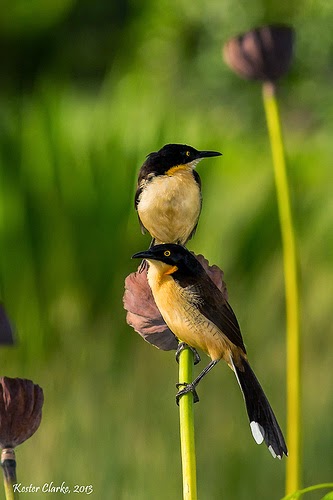Description
Habitat
Donacobius is resident along river edges with brushy areas and with invading dense vegetation in standing water. They need marshes for breeding. Black-capped Donacobiuses are common in a wide range of Amazonian wetlands.
Voice
Donacobius pair utters fascinating duets. Both perch close to each other, one above the other, and often facing each other. They call while bobbing their heads and wagging their fanned tails jerkily. The upper bird utters a hard “chrrr” and the other a loud “kweea”. At this time, we can often see the orange-yellow pouches exposed.
This melodious duet lasts some seconds, and it is used for to keep away potential intruders. Male gives series of liquid whistles and female utters a lower grating sound. Male’s call varies in intensity from slow repetitions of whistles to rapid bursts of notes when it is very excited.
Diet
Donacobius feeds mainly on invertebrates. It gleans from leaf surface in grass, and may also catch flying insects, from low perches over water. It forages in vegetation and grassy marshes where it probes and plugs insects. Donacobius is probably entirely resident in its range. Pairs live in narrow territories along water edges. A large portion consists of marshy edges.
Reproduction
It is a bulky open cup (external sizes 10 to 15 cm) with a nesting cup of 6cm depth and 8 cm in diameter. Nest is made with grass, plant fibers, and other materials frequently added, such as snake skins and silk from spider webs and cocoons. Donacobius may also take some materials from nests of other species. Breeding occurs during rainy months.
Female lays 2 purplish-white eggs, heavily spotted with reddish and purplish. Incubation lasts about 16 to 18 days, by female alone. Altricial chicks are naked at hatching. Adults wet them with their own soaked feathers, after immersion into the water.
Young are fed by both parents, but also by helpers which are offspring from the last breeding season, or for one or two seasons before. Young fledge when they are 17 to 18 days old.
When nesting care is shared by pair and helpers, broods are more productive. Helpers assist breeding pair in defense of the territory, feeding young and guarding the nest.
This species seems to produce one single brood and a second clutch of replacement if the first is lost. But sometimes, pair may produce two broods per year. Mates stay together all their life.
Photos by others.







No comments:
Post a Comment